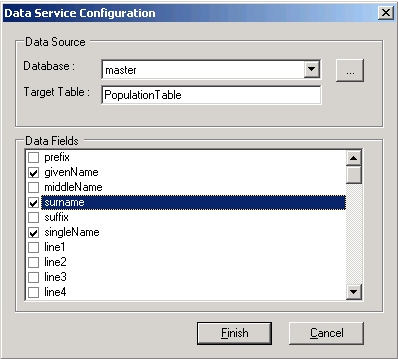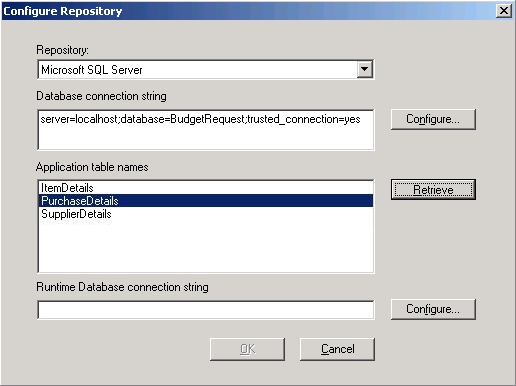Data Population allows you to write to a database (SQL or Oracle) the desired application data values. The data can then be used for reporting purposes. For Data Population, the data tracking database that is created should include table columns based on the fields from the form, the Primary Key should be the Process Instance ID.
The configuration is done via AgilePoint Envision.
To setup the Data Population:
- Click the Data Population
link in the Process Templates Properties pane.
The Connecting to Server window appears.
- Select the Logon type and
click OK.
The Data Population Configuration window appears. This windows allows you to select either a Basic or Advanced way of configuring the repository and setting up the mapping for data population.
- Select one of the following:
- Basic - Suitable only for development environments where the data source resides on the same machine as the AgilePoint Envision client.
- Advanced - Suitable for environments where the data source resides on a separate machine from the AgilePoint Envision client.
If you selected the Basic option, the Data Service Configuration window appears.
- Click the Ellipses button to populate the database list with all the databases on the server.
- (Optional) Change the Target Table name if desired.
- Select the Data Fields from the forms schema for which to populate data to the database.
- Click Finish.
If you selected the Advanced option, the Configuration Repository window appears.
- In the Repository field, select either Microsoft SQL Server or Oracle to write the data to a database, or SharePoint list to write the data to a SharePoint list.
- Do one of the following:
- Click the Configure button to configure the database connection details.
- Click the Retrieve button to retrieve the database table names.
- (Optional) In the Runtime Database connection string field, enter the database connection string that will be used at runtime.
- Click OK.
- In the Site URL field, enter the SharePoint Site URL for the list and click the green arrow to sync with the list.
- In the List Name field, select the list(s) name(s) for which to populate data. Also select the Primary Key to be used for each list.
- (Optional) In the Runtime Server URL field, enter the SharePoint site URL that will be used at runtime.
- Click
OK. The Schema Mapper window appears.
The left window pane shows the form's Schema, the right side shows the database structure.
- Map the fields accordingly from the form's schema on the left to the database fields (and all the attributes on the right). To map an element to the processId drag and drop as usual to the respective field, while mapping to a processed, the right element must be of type string, else it will give an error message.
- You will see the connection lines appear as shown above. The connection lines may show different colors based on the compatibility of the data types as follows:
- After the mapping is complete, click OK to save the mapping and close. At runtime, the database or SharePoint List is populated with the values of the form fields.




